Studio Visit: Jólan van der Wiel
The experimental Amsterdam designer shows the strengths of using gravity as a medium

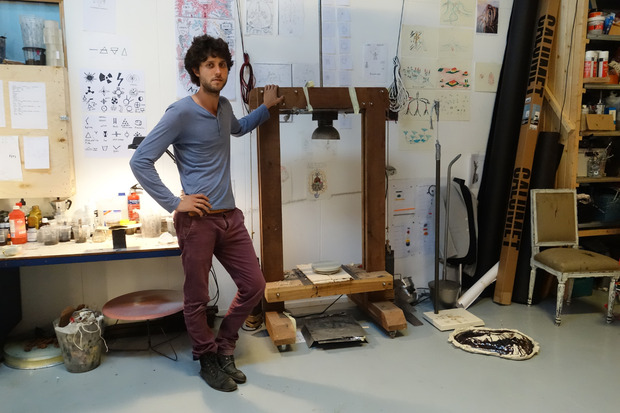
With its large weighted wooden frame, pulleys and ropes aplenty, Jólan van der Wiel‘s experiments into gravity as a natural design force is a perfect example of The Netherlands’ process-driven design ethos. An extension of the work by those rogues at Droog and the provocative Marcel Wanders, his work is driven by a transparent creative streak, and progressive use of materials and production methods. The designer graciously welcomed us into his Amsterdam studio for a chat, just weeks before welcoming his first child and despite being soaked to the skin from an uncharacteristic summer downpour.
Van der Wiel’s Gravity Stool demonstration during the 2012 Milan Design Festival was undoubtedly one of the highlights and a genuine design attraction. Something a designer could grasp, something a journalist could understand and—more importantly—something Ms or Mr J Average could comprehend and enjoy. It was a real tangible demonstration of design and what a designer does. “It’s an honest production method; something that attracts people and can be read by anyone, young or old,” smiles van der Wiel.
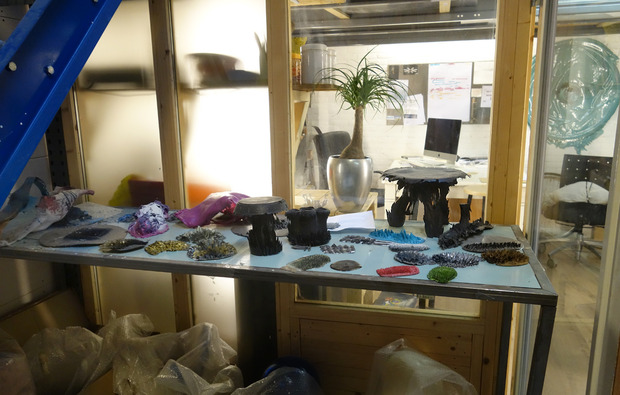
It’s based on experience and hands-on doing, plus encouraging a curiosity in the way things work.
A product of the Dutch design system, he graduated from the designLAB department of the Gerrit Rietveld Academie (where he currently teaches) following a year at the renowned Eindhoven Academy. He cites Netherlands’ design education system as a strong enabler of the style which emerges from the country’s collective output: “It’s based on experience and hands-on doing, plus encouraging a curiosity in the way things work.” Casting our eye about the studio, it’s certainly a demonstration of investigative design, with structures and machines dotted about.

“By being curious, you can think about anything in the world in your own way and redevelop it for yourself by thinking about how it works,” he continues. Van der Wiel is quick to point out that there is a degree of cultural influence which finds its way into his work, stating that even before education everyone is given the space to look around and play with things. “There’s this mindset rooted into the culture; that you can do anything you want.” The designer feels that freedom fosters a high number of designers who examine the smaller things more than designers of other nationalities, which creates a lot of specialisms—like van der Weil himself, and his work (and interest) in making gravity, as a force, visible.
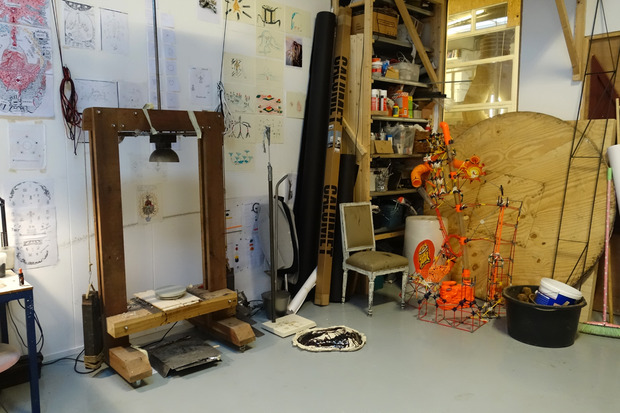
When asked how the project came to fruition, he recalls sitting to plan his graduation project and considering what kind of designer he could be and how he could himself be intrigued by his field. “I saw I couldn’t make something that I’d designed myself. I can see lines and circles, but nothing is ever as beautiful as I would have wanted. But I was interested in natural forces, their beauty and rawness and delicacy. If I could somehow grab those forces and manipulate them into a production method then that would be really interesting.” And so the Gravity machine came into being.
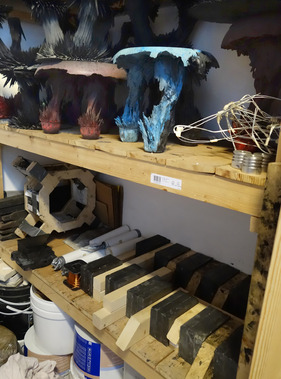

“I made a machine that could collaborate with a natural force,” he says. The designer spent a relatively short time developing both machine and the right mix of plastic, a total of just two months. Much of the time was invested in the plastic: “There are lots of liquid plastics out there but they weren’t creating the right kind of forms when dried and stretched—some too rounded in the corners, others just too sharp and brittle.”
I’d rather develop things that can be used.
Yet in truth, van der Weil didn’t actually know whether the machine would properly work until a day before his graduation project was due to be shown for the first time. Thankfully, as we know today, not only did it work but the results are spectacular—the machine itself and its medieval pulleys suspended from the overbuilt wooden frame and the mixture of plastic and metal filings pulling slowly upwards towards the magnets make for compelling viewing and usable products. “I’d rather develop things that can be used. It’s important to try and make objects that show how these forces can be used to create something for everyday life. My part of the process as a designer is to influence the shape so it can be used in our world,” he notes intently.

Aside from the stool, van der Weil was asked by Dutch fashion designer, Iris van Herpen to use the gravity technique to create two magnetic dresses. “I was interested in seeing how I could apply the force to the human body,” he says. “There’s iron in our body so the idea was to make a dress like the material was growing out of the body itself. So I found Herpen, who is experimental like me. It was the first time I collaborated with another discipline, which I liked. There were two dresses in total that took five months with five people to make a single dress. They’re flexible though; 40kg of soft cuddliness!”
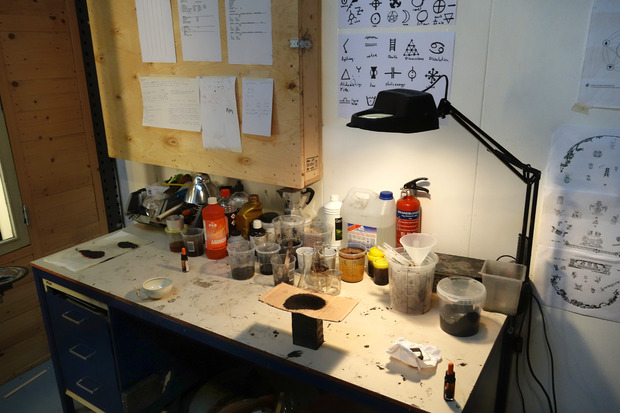
Fast forward to this spring and the designer showed an extension of the project, Dragonstone to the Dutch Invertuals group show. Based around the same principle, harnessing the invisible forces of magnetism, Dragonstone takes a new direction and brings in a new material formula for van den Weil. “It’s a clay power and metal. A ceramic with totally different capabilities and I think I prefer working with it as I’m creating much closer to nature. A closer relation to the force. And I also know now that it works well with cement and concrete.”
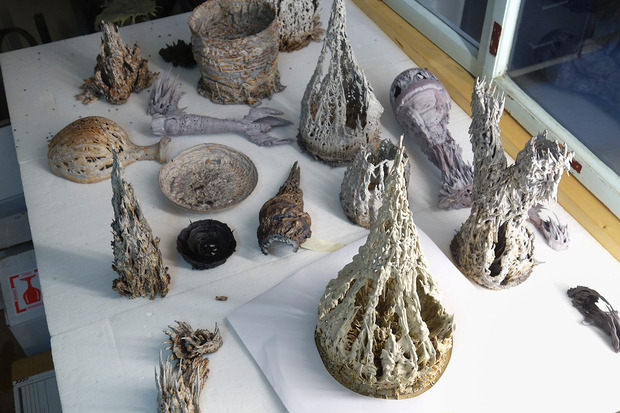
Van der Weil believes that Dragonstone is a creative process that could well be applied to architecture and constructions on a large scale, with a designer or architect actively “building” structures or amending them on site. It uses much bigger magnets to build layers of Dragonstone structure upwards or extend them outwards, according to the directional pull of the magnets. Instead of one seamless motion as with the Gravity machine, Dragonstone has to be built in layers as the curing process for the new ceramic takes time and needs to dry completely for strength. Yet, once set, it’s a solid material with similar properties to reinforced concrete, its metal fibers adding tensile strength to the clay or concrete.
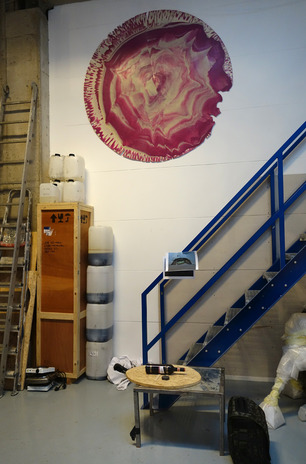
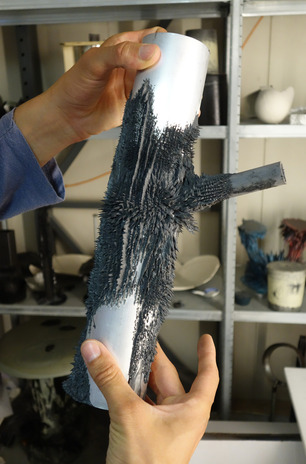
“Unlike a regular concrete, the metal and magnets can be used to hold a form in shape while cooling, so you don’t need a mould,” he explains, adding that as long as the magnet is close the structure will hold its form proudly. In van der Weil’s mind, he sees a situation in which an architect is given the true power of construction, freeing them up to be more reactive to a build’s demands and growing new structures.
Rarely does one see true experimentalism in design today. There’s oftentimes an underlying commercial subtext, or a narcissistic streak in the work or the rehashing of a method long forgotten. Jólan van der Wiel is far from this: a curious, humble servant of his own investigative mind whose output really does enthrall the viewer in all respects. And design is lucky to still have people like that.
Photos by Karen Day










